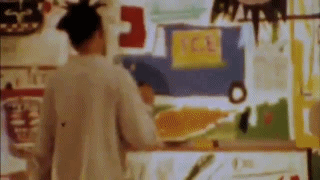PROJECT 3 BY
Gabriella Maura Kurnianto
s3762302



Jean-Michel Basquiat


_PNG.png)

#01
Before diving into the art industry, you were doing street art in downtown New York
signing as SAMO with Al-Diaz.
How did the name SAMO come up?
SAMO..It’s pronounced ‘same-oh’ which initially means same old sh*t. It started off as a private joke. We needed a topic for our newspaper article in school and were talking about this ideal religion, but it was fake...made up and called it SAMO. We also printed flyers that featured testimonials about people converting to SAMO. So me and Al diaz went with the name. It became a medium to vent out our frustrations, thoughts as a teenager, basically anything through graffiti.



The SAMO graffiti was everywhere, people became curious and you finally revealed yourself. How did it go from there? Does your popularity continue to rise?
After samo, I started to focus on doing more paintings. I met and knew a lot of creative people and my paintings were exhibited in galleries like Anina Nosei’s and Tony Shafrazi’s, but people were still pretty slow in recognizing and appreciating my work because it’s different to what people are used to seeing.
Then I started making collaborative pieces with Andy Warhol. He’s very influential in the art world and I look up to him, because he flattens the boundaries between high art and pop culture. Until then more people became familiar with my art style.




#03
We are also aware that racism has been a big issue. As a successful artist, what was the art industry like when it came to race? How does it affect your career as an artist?
The high art community was an overly white and privileged community. People would often label me as the ‘wild primitive painter’. It was tough because most people just don’t take you seriously..and they would underestimate. Rumours are also not uncommon. There would be rumours about me being locked up in the basement, forced to make art, rumors about having an underground connection so just I could get to the stage I’m in. They didn’t want to believe I was successful.


Jackson Pollock (right) , Jean-Michel Basquiat (left)

Willem De Kooning (left), Jean-Michel Basquiat (right)

Pablo Picasso (left), Jean-Michel Basquiat (right)

Jackson Pollock (right) , Jean-Michel Basquiat (left)


I get inspiration from the things I see all the time. Social issues, famous artworks, books, songs, everything. I try to think about life when I paint and the experience I went through. I also wanted to portray my cultural heritage in the paintings because you don’t see a lot of black people in modern art. They’re never portrayed realistically.
Now let’s talk about your artwork. What is your artwork based on? Where do you get your
inspiration from?





Earlier on, the art industry would not present street art as it wasn’t considered high art.
How do you think you changed the art industry with your style?
Art was mostly minimal when I came up and it confuses me a little but. I thought it divided people a little bit and I wanted to change it.
I initially wanted to challenge traditional art because I thought it was very limited and alienating. I wanted to make very direct paintings that people would feel the emotion behind when they saw them.
I also put a lot of words in my paintings because I wanted it to be informative. People got used to this kind of art and finally acknowledged it. I guess it became a new era.
